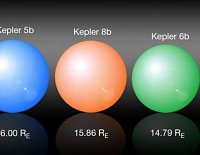
Kepler is a Discovery-class mission designed to determine the frequency of Earth-size planets in and near the habitable zone of solar-like stars. The instrument consists of a 0.95 m aperture photometer designed to obtain high precision photometric measurement of >= 100,000 stars to search for patterns of transits. The focal plane of the Schmidt-type telescope contains 42 CCDs with a total of 95 megapixels that cover 115 square degrees of sky. The photometer was launched into an Earth-trailing heliocentric orbit on March 6, 2009, finished its commissioning on May 12 and is now in the science operations mode.
The first six weeks of data show the presence of hundreds of candidate planets, eclipsing binary stars and variable stars of amazing variety. Discoveries of five new exoplanets are shown and compared with known exoplanets with respect to mass, size, density and orbital period. Detection of stellar oscillations and unusual objects also are presented.
 A Talk With Jim Green
A Talk With Jim Green What Can Extant Genomes Reveal About Early DNA Metabolism?
What Can Extant Genomes Reveal About Early DNA Metabolism? What We Talk About When We Talk About Earth's Oxygenation
What We Talk About When We Talk About Earth's Oxygenation Bowling With Astrobiologists: A Twisted Path Toward the Origin of DNA
Bowling With Astrobiologists: A Twisted Path Toward the Origin of DNA